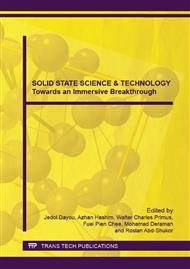[1]
Information on http: /www. dvs. gov. my/en.
Google Scholar
[2]
G.G. Gungor-Demirci, and G.N. Demirer, Effect of initial COD concentration, nutrient addition, temperature and microbial acclimation on anaerobic treatability of broiler and cattle manure, Bioresour. Technol. 93 (2004) 109-117.
DOI: 10.1016/j.biortech.2003.10.019
Google Scholar
[3]
F. Abouelenien, W. Fujuwara, Y. Namba, M. Kosseva, Nishio, and Y. Nakashimada, Improved methane fermentation of methane manure via ammonia removal by biogas recycle, Bioresour. Technol. 101 (2010) 6368-6373.
DOI: 10.1016/j.biortech.2010.03.071
Google Scholar
[4]
E. Salminen, and J. Rintala, Anaerobic digestion of organic solid poultry slaughterhouse waste-a review, Bioresour. Technol. 83 (2002) 13-26.
DOI: 10.1016/s0960-8524(01)00199-7
Google Scholar
[5]
Y. Chen, J.J. Cheng, and K.S. Creamer, Inhibition of anaerobic digestion process: a review, Bioresour. Technol. 99 (2008) 4044-4064.
DOI: 10.1016/j.biortech.2007.01.057
Google Scholar
[6]
H.B. Nielsen, and I. Angelidaki, Strategies for optimizing recovery of the biogas process following ammonia inhibition, Bioresour. Technol. 99 (2008) 7995-8001.
DOI: 10.1016/j.biortech.2008.03.049
Google Scholar
[7]
P.H. Liao, A. Chen, and K.V. Lo, Removal of nitrogen from swine manure wastewater by ammonia stripping, Bioresour. Technol. 54 (1995) 17–20.
DOI: 10.1016/0960-8524(95)00105-0
Google Scholar
[8]
N.I. Krylova, R.E. Khabiboulline, R.P. Naummova, and M.A. Nagel, The influence of ammonium and methods for removal during the anaerobic treatment of poultry manure, J. Chem. Tech. Biotechnol. 70 (1997) 99-105.
DOI: 10.1002/(sici)1097-4660(199709)70:1<99::aid-jctb684>3.0.co;2-c
Google Scholar
[9]
Information on http: /www. ianrpubs. unl. edu/epublic.
Google Scholar
[10]
M.F. Jamaludin, and N. Zainol, Isolation and Identification of Acetic Acid Producer from Mixed Culture of Soil and Banana Stem Waste in Anaerobic Condition. Inter. Jour of Chem. and Environ. Eng. (2011).
Google Scholar
[11]
L.O. Santos, R.M. Alegre, C. Garcia-Diego, and J. Cuellar, Effects of magnetic fields on biomass and glutathione production by the yeast Saccharomyces cerevisiae, Process Biochem. 45 (2010) 1362-1367.
DOI: 10.1016/j.procbio.2010.05.008
Google Scholar
[12]
Z.G. Liu, X.F. Zhou, Y.L. Zhang, and H.G. Zhu, Enhanced anaerobic treatment of CSTR-digested effluent from poultry manure: the effect of ammonia inhibition, Waste Manage. 32 (2012) 137-143.
DOI: 10.1016/j.wasman.2011.09.015
Google Scholar
[13]
T. Liu, and S. Sung, Ammonia inhibition on thermophilic aceticlastic methanogens, Water Sci. Technol. 45 (2002) 113–120.
DOI: 10.2166/wst.2002.0304
Google Scholar
[14]
J. Lobos, C. Wisniewski, M. Heran, and A. Grasmick, Sequencing versus continuous membrane bioreactors: effect of substrate to biomass ratio (F/M) on process performance, J. Membr. Sci. 317 (2008) 71-77.
DOI: 10.1016/j.memsci.2007.08.041
Google Scholar
[15]
Information on http: /cru. cahe. wsu. edu/CEPublications/eb1475/eb1475.
Google Scholar
[16]
K. Yetilmezsoy, and Z. Sapci-Zengin, Recovery of ammonium nitrogen from the effluent of UASB treating poultry manure wastewater by MAP precipitation as a slow release fertilizer, J. Hazard. Mater. 166 (2009) 260-269.
DOI: 10.1016/j.jhazmat.2008.11.025
Google Scholar
[17]
F. Abouelenien, Y. Nakashimada, and N. Nishio, Dry mesophillic fermentation of chicken manure for production of methane by repeated batch culture, J. Biosc. and Bioeng. 3 (2009) 293-295.
DOI: 10.1016/j.jbiosc.2008.10.009
Google Scholar


